The success of the Liverpool and Manchester Railway, opened in 1830, pointed the way to a new transport age. One of the next major projects was the London and Birmingham Railway and once the enabling Act of Parliament had been obtained Robert Stephenson was appointed engineer-in-chief in September 1833. Costing, organizing and executing a civil engineering task of this magnitude was unprecedented. There was very little previous experience to rely on. The building of the line is thus of particular historical significance.
Although parts of the line at its southern and northern ends were opened in 1837, through working was delayed until September 1838 due to problems with Kilsby Tunnel and Blisworth cutting.That these were ultimately overcome and the railway went on to operational and commercial success proved that Robert Stephenson was indeed one of the most gifted engineers of the Victorian era.
Construction of the line was divided into 30 contracts. Three consecutive contracts, Kings Langley, Berkhamsted and Aldbury, numbered 4B, 5B and 6B were awarded to W & L Cubitt. 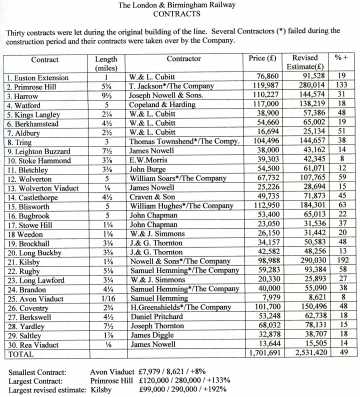 The contract numbers are one step out of sequence with the list shown here as the Euston Extension was added later. Together these 3 contracts were for an approximately 10 mile section from Kings Langley (just north of Watford Tunnel) to Tring Station. I have the original civil engineering records from 1836/7 for these contracts. They are contained within a single ledger probably because the work was undertaken by the one company. For each built structure the types and quantities of materials used are recorded at approximately monthly intervals. For cuttings and embankments earth quantities & movements are given.
The contract numbers are one step out of sequence with the list shown here as the Euston Extension was added later. Together these 3 contracts were for an approximately 10 mile section from Kings Langley (just north of Watford Tunnel) to Tring Station. I have the original civil engineering records from 1836/7 for these contracts. They are contained within a single ledger probably because the work was undertaken by the one company. For each built structure the types and quantities of materials used are recorded at approximately monthly intervals. For cuttings and embankments earth quantities & movements are given.
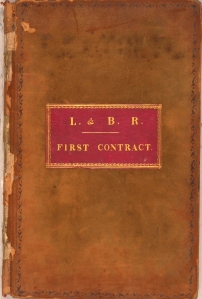
Examples of the structures included are: Northchurch Tunnel (Berkhamsted), Nash Mills Canal Bridge, Boxmoor (Hemel Hempstead) Skew & Canal Bridges, Boxmoor Temporary Terminus, Berkhamsted & Tring Stations, other minor bridges (24 bridges in total), fencing and ditching, permanent way laid (lineal yards).
4 of the works in this section were illustrated by J. C. Bourne in his contemporary record of construction of the line: Nash Mills Canal Bridge, Berkhamsted (cutting), Boxmoor Skew Bridge and Boxmoor Embankment.
Contract 5B was published as a sample contract in S.C. Brees’ “Railway Practice”. Bringing these sources together provides – the contract, the actual civil engineering and a contemporary pictorial record.
The contents of the ledger, more than 50 pages, have been digitally imaged in studio. I can provide a copy of the full contents on CD for purchase if so desired. I have also been able to identify the map location (longitude/latitude) of each structure and the probable location of each excavation (cutting/embankment) and these details are also provided on the CD.
Examples of the contents of the ledger are illustrated on some other pages of this website:
– Northchurch Tunnel (Berkhamsted) ( GO TO )
– Boxmoor Temporary Terminus ( GO TO )
– Nash Mills & Boxmoor Canal Bridges ( GO TO )
– Boxmoor Skew Bridge ( GO TO )
The London and Birmingham Railway: a bit of history from 1839
The cost estimates for the building of the 112½ mile London and Birmingham Railway were hopelessly optimistic. The original incorporating Act of Parliament had authorized the raising of £2,500,000 via £100 shares.
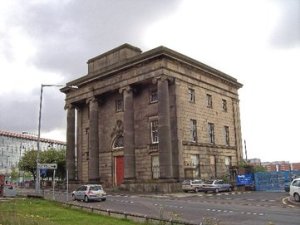
However by the time the line from Euston Square to Curzon Street terminus in Birmingham opened as a through route on 17’th September 1938 two further Acts had been needed to raise the capital to £4,500,000. [The company had obtained £2,375,000 from shareholders and £2,125,000 via loans.] This still proved inadequate and in the spring of 1839 the railway had another Bill before Parliament seeking authority to raise a further one million pounds through a third share issue.  The minutes of the evidence taken during the committee stage of this Bill, in March and April 1839, provides a fascinating insight into the early operation of the railway. The main aim of the committee was to lay bare the financial position of the company and to determine whether or not the raising of this extra capital was really justified. However the dissecting questions put by legal council to the company secretary, general superintendent and one of the directors also reveals a lot about the operational arrangements at a time when, just like the embankments, things were still bedding down.
The minutes of the evidence taken during the committee stage of this Bill, in March and April 1839, provides a fascinating insight into the early operation of the railway. The main aim of the committee was to lay bare the financial position of the company and to determine whether or not the raising of this extra capital was really justified. However the dissecting questions put by legal council to the company secretary, general superintendent and one of the directors also reveals a lot about the operational arrangements at a time when, just like the embankments, things were still bedding down.
The interrogation of the railway officers revealed that the company had been somewhat devious in the way it had raised its funds. It had also exceeded the authority Parliament had given for this. Mr Creed the company secretary was forced to admit that beyond the £4½ million approved capital the railway had other borrowings and debts, as at 15/3/1839, of £631,000; or maybe more. Much of this borrowing had been secured against future revenue. It was therefore rather presumptive to come back to Parliament with a request to raise an additional £1 million when the railway had actually already spent around 2/3 of this sum. Parliament was hardly able to refuse and allow the endeavour to fail.
Existing share holders had not been required to pay the full amount for each share. For the original £100 shares only £90 had been paid up. These shareholders were then offered, pro-rata, £25 shares for which they only had to pay £5. The remaining amount had been borrowed against the security of a call upon the shareholders for the outstanding value of the shares. This put the holders of the £25 shares in a very favourable financial position. They received a dividend on the full £25 share value yet had only paid out £5. In the 6 months since the full opening of the railway this had given a 35% annualized return on the £5 investment. Knowledge of this had inflated the value of these shares which could be sold at a very healthy profit. However if the shares were retained and the loans then paid back out of the general revenue of the company the shareholders might never have to pay the remaining £20. The company officials had to admit that this arrangement for raising funds by borrowing rather than calls upon shareholders had been wrong. Their excuse was that if they had not done so construction would have been delayed or postponed. The committee tried to impose ways to correct the matter but legal council insisted that this was impossible without breaching legal obligations to lenders and upsetting the general money markets. It was agreed though that future share issues would not be managed in this way.
The questions put by the opposition lawyers reveals a mentality stuck in the canal and turnpike era. No doubt this would change dramatically in the coming years. The peak of the railway “mania” was less than a decade away and 1846 was to see the greatest number of railway Acts submitted to Parliament in a single year at 271. They seemed unable to grasp the concept of a unified fare covering all the cost of a journey on the line. Repeatedly the company officials are asked what part of the charge was for “the toll” and what for “locomotive power”. The company accounts were not ordered in a manner able to answer this.
The London and Birmingham was principally a passenger railway. At the time of the committee hearings, six months after through route opening, it was running 7 trains on weekdays and 4 on Sundays in each direction. There were 4 classes: second class open, second class closed, first class and the mail coach (the most prestigious). “Open” meant no protection whatsoever from the elements. This was basically a 4 wheeled truck with benches and capable of carrying up to 24 passengers. The “closed” second class carriage was used with the night mail train. The fares for the full trip were 20s, 25s, 30s and 35s respectively. This was about 2d, 2½d, 3d and 3½d per mile. The most profitable were the second class passengers. This was simply because more could be crammed into each carriage and these carriages cost much less to manufacture and maintain. The unlined (i.e. non-upholstered) second class carriage cost £130 to £150. In comparison the first class carriage cost £460 to £480 and accommodated only 18 passengers. These were more prone to wear and tear and needed repainting and relining at least annually. The mail coach cost £500 to £520 and had a coupe for 2 and a compartment for 4, with 2 to 4 outside seats. An audit during October 1838 showed the ratios of passengers, mail : first : second as 1 : 2.5 : 3.2, i.e. one mail coach passenger for every 3.2 second class passengers with a average fare of around 2¾d per mile. When compared to airlines today this is a healthy proportion of higher tariff passengers. The fact that the railway was making little profit from the more prestigious clients suggests that the fare differentials were too low, i.e. they weren’t charging enough for the first and mail passengers. The committee suggested that the railway revenues might improve if they lowered fares to attract more passengers. There had been a debate amongst the directors about this but it was a dangerous strategy. Mr Boothby, the director examined by the committee, stated that if fares were reduced by 1/3 it would be necessary for the traffic to double to generate the same dividend. Indeed when the line had been partially opened from London to Tring in September 1837 the fares had been much lower and the railway had operated at a loss.
At any rate trains were running well below capacity. The average loading was 55 persons per train whereas if full of second class passengers the maximum was around 200. The journey time between London and Birmingham was 6 hours for first class trains (stopping only at principal stations) and 6½ hours for second class trains stopping at all stations. The fastest train was the day mail which did the journey in 5 hours which is an average speed, including stops of 22.5 mph. This was barely twice the fastest stage coach of the era at a time when the main turnpike roads were in generally good order.
The dedicated first class trains highlighted social class divisions and prejudices. Quoting directly from the minutes, “Q: Would there be any objection. . .that one second class carriage be attached to each first class train? . . . complaints are made, on the part of gentlemen, that servants, when traveling by a first class train, are frequently placed by the side of ladies in the same carriage, sometimes eating a mutton chop, and at other times a pork pie; besides which, gentlemen are obliged to pay the expense of the first class train for their servants. A: . . .the board (of the railway) has provided, outside the first class carriages, seats in which they may put their servants at the second class fares.” The outside seats were placed high up at the ends of the carriages in the manner of stage coaches. This was a very exposed position and one can imagine the experience passing through long tunnels at the slow running speeds. A concession to female servants on these first class trains was that they were allowed to ride inside at second class fare.
The conveying of horses and their carriages was the most unprofitable traffic. The power needed to draw one horse in a box was thought greater than that to pull a passenger (railway) carriage. Gentlemen’s carriages and horses needed to be at stations at least a quarter of an hour before the time of departure. Trucks (flat wagons) were kept at the principal stations but to prevent disappointment it was recommended that these should be booked in advance. The rate for a carriage with four wheels was 75s for the whole distance, but if two carriages with two wheels could be placed on one flat wagon this was only 55s. The fare for a horse from Birmingham to London was 50s, i.e. the same as one second class + one first class passenger, but requiring its own box. Passengers that remained either in or on gentlemen’s carriages, and grooms in charge of horses were charged second class fares. This was the motorail service of the 1830’s.
The secretary was asked about speeds on other railways and he thought the Liverpool and Manchester managed 30mph, and the GWR 35mph. His excuse for the relative slowness on the L&B was the need to pass carefully over some of the embankments which were still consolidating, and the disciplines of adhering to a published timetable. In places speed restrictions were 10 mph or less (where now Virgin pedolinos whisk by). The evidence often makes comparison with the Grand Junction Railway, which ran from an adjacent terminus in Birmingham to Warrington and thence to Liverpool and Manchester. At this time that railway used a starting departure time but unlike the L&B didn’t wait for time at intermediate stations and had a generally poorer punctuality record.
During these first months it was proving impossible to accurately predict the cost of operating locomotives. The plan had been for Mr Bury (of Liverpool) to manufacture and run locomotives under contract at a farthing per passenger mile and ½d per ton of goods per mile. This was based on early experience with the Liverpool and Manchester railway. These figures were quickly found to be invalid. Even on the L&M locomotive costs rose substantially after 3 or 4 years when heavy repairs to the engines became necessary. On the L&B the higher cost of coal and poorer than expected passenger numbers were other factors that pushed up motive power costs. The anticipated increasing speeds would also raise fuel consumption and increase wear and tear on loco’s and track. By April 1839 the figure had reached 7/16d per passenger mile and was still rising. The idea of a contract was dropped and Mr Bury’s services were hired on a salaried basis and the company itself took direct control of locomotive finances.
Mr Boothby (company director) reported that locomotives for passenger work were of a different power from those intended to convey merchandise. They were all of the 4 wheeled type as was the case on the Liverpool and Manchester, North Union, London and Southampton, Bolton, and Midland Counties railways at this time. The only 6 wheeled engines on the L&B were for ballast trains. The Grand Junction Railway however used exclusively 6 wheeled engines. Robert Stephenson, chief engineer for the L&B, was an advocate (and manufacturer) of 6 wheeled loco’s. The company may not have wished to be unduly dependent on him and thus turned to Mr Bury for its locomotives. Much of the questioning was to determine how open to competition the L & B was. This included whether they would allow locomotives from other railway companies to operate on the line. Much of this revolved around practical issues such as access to water and station facilities. The company officials conceded that the legislation allowed others use of their facilities but in reality they were not going to let this happen easily. They insisted that any individual arrangements they had already made did not set a precedent for everyone else and that water would only be supplied at an appropriate price decided by them; otherwise let them build their own stations and pipe-work. They were quizzed as to whether the GJR’s 6 wheeled loco’s would fit on the L&B turnplates but not definitive answer was provided.
In the transport of goods the role of the railway was just to provide the locomotives and wagons. It was not itself “the carrier”. If the public wished goods to be sent via the railway this was organized by other businesses that also took care of the movement of goods to and from the railway premises. These carriers in effect purchased capacity on trains and were obliged to cart items away from stations within 6 hours of arrival. The Bill (i.e. the request to raise more money) was opposed by one such carrier, a Mr John Robins. His objection was that the railway was giving preferential treatment to Pickfords and Co, who’d been the sole carrier when the line first opened. [Some of the evidence given did suggest that they had enjoyed a generous mark up on the carriage of some goods and that competition from other carriers would bring charges down; both on the railway and canal.] Mr Robins claimed that the railway was not honouring its legal obligation to allow free and fair competition and to deal with all users of its facilities on even terms. Initially the company denied this but questioning quickly revealed a conflict of interest in that the General Superintendent of the railway, a Mr Baxendale, and a share holder in it, was also a partner in Pickfords and Co. The committee put pressure upon the railway officials to be more overtly and fairly open to all carriers. A general fee structure for all carriers could not be agreed because of the issue of empty wagons traveling back from London to Birmingham – and who should pay for this. In the transport of goods the railway was in competition with the canals. The railway was more expensive but offered greater speed. There was a demand to hurry goods from the north to London for sale or export. There was less to transport in the other direction and less of a rush. There was therefore unused capacity within the wagons returning to Birmingham and the company suggested, as an experiment, charges to carriers of 30 shillings per ton from Birmingham to London and 33 shillings in the opposite direction. Understandably not all carriers were happy with this.
The average daily movement of goods between September 1838 and March 1839 was 72 tons 6 cwt. Nowadays this could be done by two lorries! The railway was only interested in handling the more lucrative general merchandise and in relatively small amounts. There was no intention to transport heavier goods such a stone and coal. The canals could do that. The company provided wagons and locomotive power at a charge of 12s a ton per round trip, to and from London and Birmingham. These figures are a little at odds with those above but this may be because they do not include the “toll” component, i.e. the access charge. Freight charges seem to have been in a state of flux because of the uncertainty over locomotive costs. A wagon could carry up to 4 tons but this was soon restricted to 3½ tons. Loading was though not to be less than 2½ tons. One locomotive could only manage a train of 100 to 120 tons. Where necessary double heading, rather than banking was used. This was recommended if a passenger train consisted of more than 12 carriages, or 14 in good weather.
Fare dodging had been frequent in the early days, both from passengers traveling in a higher class of carriage or beyond the destination which their ticket allowed. “As much as £50 or £60 had been recovered in one week.” The practice had been curtailed somewhat by requiring tickets “to be presented at the last station before London or Birmingham”. Checking tickets in transit was considered impractical as it would have involved employing a guard in each carriage.
When asked about cost comparisons with other railways Mr Boothby (company director) gave figures per mile of £24,000 for the Grand Junction Railway, £42,000 for the Liverpool and Manchester and around £50,000 for the L&B. His justification for the differences were that the quantity of earthworks on the L&B had been nearly four times that on the GJR, with numerous expensive tunnels, viaducts, embankments and cuttings. There were large over spends (and delays) on Kilsby tunnel and Blisworth cutting. The 1¼ mile extension from Camden to Euston had been particularly expensive at between £300,000 and £400,000 once property purchases were included. Not one of the 30 main contracts had been completed to budget. For all of this the humble navvie was paid 4/6 (22½p) a day + beer.
The Act authorizing the requested additional £1 million was passed on 14’th June 1839 but, in the words of John Britton in his account of the line published that year, “granted (only) after a long and searching investigation into the affairs of the Company”.
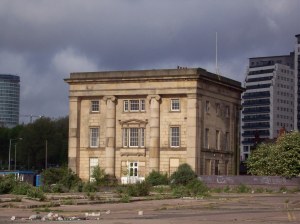
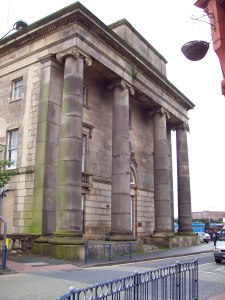
![Curzon_St_station[1]](https://oldrailwaystuff.com/wp-content/uploads/2015/05/curzon_st_station1.jpg?w=300&h=225)

Hello – I am researching the history of the London and Birmingham Railway and found the information you have collated fascinating. Are you able to share the sources for the material, particularly with regards to train times and the different classes of travel then available? Thanks – Richard
LikeLike
Thank you for your message. It’s been along time since I received any from what is my hobby website. I wrote the piece about the London & Birmingham Railway about a decade ago using sources in my own possession. The two main ones areas mentioned in the article:
– A ledger containing the civil engineering records for the building of a section of the line from just north of Watford Tunnel to Tring Station.
– A volume titled, “Minutes of Evidence taken before The Committee on the London and Birmingham Railway Bill.” [ordered by the House of Commons to be printed 2 May 1839]. The proceedings/questioning of witness to place in the March of that year. It’s not something that has a ISBN number. I can send you of photo of it, if you wish, so that you know what I am on about. If so please send me your e-mail address to mine which is chriseyeman@gmail.com
Regards
Chris Heaven
Chorley
Lancs
LikeLike
Thanks for replying Chris. I will drop you an email. Best wishes, Richard
LikeLike